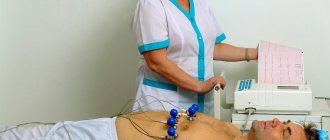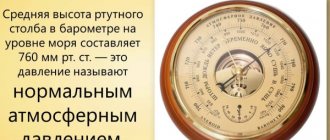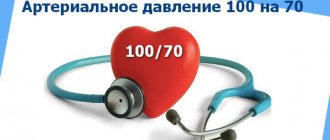Date of publication: 04/06/2017
until November 30
We are giving away 1000 rubles for all services for a visit in November More details All promotions
Blood or arterial pressure is the pressure of blood on the walls of blood vessels. It is determined by the volume of blood that the heart pushes out per unit time, and the strength of the vascular response resistance. Pressure creates conditions that allow blood to reach organs and supply them with oxygen and the nutrients it transports. It is believed that a person’s blood pressure is normal when the heart copes with its pumping function and the blood vessels remain elastic and strong.
Lower and upper blood pressure
In a healthy person, the heart muscle contracts 60 to 80 times per minute at rest. With each contraction, the heart pumps another portion of blood into the arteries. Accordingly, the maximum blood pressure on the walls of blood vessels is recorded at the moment of contraction of the heart muscle. Between contractions, the heart muscle relaxes. At the time of such rest, blood pressure is at its lowest.
The highest reading is called systolic or upper pressure. The name comes from the word “systole” - the stage of contraction. The lowest pressure reading is called diastolic (from the word “diastole” - the stage of relaxation). Systole and diastole are stages of the normal cardiac cycle.
Pressure readings are traditionally recorded in millimeters of mercury. When measuring, the upper pressure indicator is always indicated first, and the lower pressure indicator second.
Adjust individually
The question of whether it is possible to adjust indicators separately is also of concern to many. “Basically, all the drugs that we use to correct high blood pressure act on both upper and lower pressure. However, among the classes of antihypertensive drugs, we have the opportunity to select drugs with a predominant effect on systolic or diastolic pressure. Therefore, it is possible to implement a personalized approach to the patient based on his needs,” notes Maria Benevskaya.
For example, she says, medications that have a vasodilating effect will be more likely to cause a decrease in diastolic (lower) blood pressure. And drugs that reduce the force of heart contractions will reduce systolic (upper) blood pressure to a greater extent.
What pressure is considered normal?
Several factors simultaneously influence blood pressure:
- condition of the heart muscle;
- condition of the walls of blood vessels;
- the presence of deposits on the walls of blood vessels;
- person's age;
- human body type;
- a person’s lifestyle and physical activity;
- external factors, for example, region of residence.
If we summarize all these points, we can conclude that the “ideal” blood pressure is determined very individually. Of course, doctors have a standard of 120/80, but this does not mean that absolutely all people will feel good at this pressure. For example, the normal pressure indicator for petite women is 110/70, for athletes who are constantly exposed to physical activity - 130/80. A normal person may have slightly lower or higher blood pressure, and even the slightest changes will be immediately noticeable.
However, there are also extreme limits that doctors consider critical. For example, if the pressure reading is 140/90 and at the same time it tends to increase, then this is a sign of arterial hypertension. In this case, you should definitely consult a doctor, and if your general condition suddenly worsens, call an ambulance.
To bring the blood pressure back to normal, the doctor may prescribe medication. In addition to taking medications, it is necessary to change your lifestyle and eating habits: give up smoking, alcohol, fatty, heavy foods.
Extremely low blood pressure, for example 90/60, indicates that the organs are not receiving enough nutrition: the brain activity of such a person is reduced, and there is a risk of oxygen starvation. Such indicators may indicate concomitant diseases: vegetative-vascular dystonia, anemia, adrenal insufficiency, etc.
Characteristic symptoms of hypertension and hypotension
At the first stage of hypertension, pressure surges up to 159/99 mm Hg occur. Art. Most often, malaise occurs after severe overwork or stress. Patients note an increase in heart rate and headaches, weakness, and increased nervous excitability.
At the second stage, the following symptoms include: deterioration of sleep, nosebleeds, pain in the heart, severe headaches. Blood pressure rises to 160–170/100–109 mmHg. Art.
The third stage of hypertension is a serious disease that irreversibly affects the entire human body. This stage is characterized by cardiac dysfunction, chronic renal and heart failure, heart attack, and angina.
Important! If at the first stage the patient’s condition can be corrected and the disease goes away almost without a trace, but stages 2 and 3 of hypertension are practically not curable. The goal of the doctor and his patient is to monitor the condition and regularly take antihypertensive drugs that can stabilize the patient’s well-being for some time.
Low blood pressure manifests itself differently. A person suffers from headaches, which are localized in the temporal region, loss of strength, drowsiness, dizziness, nausea, and fainting. Symptoms worsen during weather changes, magnetic storms, and during acclimatization.
Both hypertension and hypotension require treatment. What it will be like and how long it will last depends on the patient’s health condition. It is necessary to strictly adhere to the treatment regimen drawn up by the doctor, without independently increasing or decreasing the dosage of drugs.
Age norms for blood pressure
Blood pressure levels can change throughout life. Sometimes this is due to a person moving to another region: the body adapts to new external conditions, so the pressure can decrease or increase within 10 points. However, in most cases, changes in blood pressure are affected by age.
With age, the walls of blood vessels become less elastic, and their internal space decreases due to various deposits and “plaques”. The response resistance from the vessels weakens, and the blood stretches their walls more strongly.
With age, a person's blood vessels become clogged and narrowed.
However, experts advise not to make serious allowances for age when measuring blood pressure. In a healthy person, it is permissible to increase blood pressure with age by 10–15 mmHg. If there is a sharp jump in pressure, then this is not due to age, but rather to the development of a disease of the cardiovascular system, which is dangerous to ignore.
Average age-related blood pressure norms in young men are slightly higher than in women, which is explained by greater muscle mass. However, with age, the rates for both sexes become approximately the same. Changes in indicators with age can be presented in the following table.
Indicators of upper and lower pressure depend on the age and gender of the person
Doctors recommend measuring blood pressure regularly and monitoring its levels starting at age 30. From the age of 40 years and over, measuring blood pressure should become a daily procedure.
What is the importance of diastolic blood pressure
Diastole refers to an indicator that includes two important factors:
- The first one determines the tension or relaxation of the capillary line. With strong compression, the diastole will be higher, which indicates a malfunction occurring in the cardiovascular department, a high risk of hypertensive syndrome. When the level is reversed, a drop in diastolic blood pressure is observed.
- The second indicates the degree of relaxation of the heart muscle during diastole. If the data is bad, the issue is related to the lack of normal rest and the heart working hard. Regular overloads over time provoke various pathological changes against the background of wear and tear.
Recorded changes should not be ignored. A timely visit to the clinic will allow you to catch the disease in the early stages, avoiding its severe course and many complications.
Blood pressure measurement
Modern devices for measuring pressure are either mechanical or electronic. When using a mechanical pressure gauge, a phonendoscope is required, with which you can hear the beginning and end of the stages of systole and diastole.
Blood pressure is measured while sitting or lying down. In order for the readings to be accurate, the pressure gauge should be at the level of the person’s heart, and the cuff should be approximately 2 cm above the elbow. Air is pumped into the cuff, causing compression of the blood vessels and the disappearance of the pulse, and then slowly released. The point at which clearly visible pulse beats appeared is noted as an indicator of upper pressure, and the point at which these beats disappear is noted as an indicator of lower pressure. An electronic pressure gauge works without a phonendoscope; in this case, indicators of upper and lower pressure, as well as pulse, are recorded automatically and displayed on the screen.
The availability of modern devices for measuring blood pressure and the ease of their operation allow everyone to regularly monitor this important vital sign of their own body and take timely measures if such a need arises.
Make an appointment Do not self-medicate. Contact our specialists who will correctly diagnose and prescribe treatment.
Importance of indicators
So is it possible to conclude which of these indicators is more important? “As we have already figured out, each of these parameters has its own meaning, so they are both important. Currently, it is also customary to distinguish between isolated systolic hypertension, when only the upper pressure is increased, and isolated diastolic hypertension when only the lower pressure is increased. Each of these forms has its own prognostic significance and some features in treatment, so it is necessary to approach the identification and correction of these types of hypertension with equal attention,” notes Maria Benevskaya.
HOW TO MONITOR PRESSURE AT HOME?
There is an official diagnostic method - “Home blood pressure monitoring”, when the results of measuring blood pressure in the morning and evening at home are entered into a table. The doctor looks at this table and adjusts the treatment. Such monitoring is especially important for “white coat” hypertension, for latent “anterior hypertension”, when the pressure is high at home but normal at a doctor’s appointment, when prescribing new antihypertensive therapy, or nocturnal hypertension.
Lethal pressure: indicator (how much?)
If the upper blood pressure reading reaches 300 mm Hg, this value is considered fatal. Irreversible destructive processes begin in the body.
Despite such high pressure, the level of blood supply to the organs becomes very low, and hypoxia develops. The brain, which has a unique circulatory system unlike other organs, is especially sensitive to a lack of oxygen.
The vascular ring located in the brain can function normally only with SBP values in the range of 80-180 mmHg.
At high levels, autoregulation of its tone is disrupted, gas exchange is disrupted, and vascular permeability jumps sharply upward. Acute hypoxia appears, followed by ischemia. If the pressure is not reduced at this moment, a fatal ischemic stroke occurs.
For the brain, the SBP level exceeds 180 mm Hg. is very dangerous.
What to do if your blood pressure rises?
At the first signs of high blood pressure, you should not immediately resort to pills. You can try using traditional herbal medicine methods:
- hawthorn - especially effective in combination with rose hips, quickly restores heart function and improves blood circulation;
- valerian root with flax seeds – normalizes blood pressure, providing a mild sedative effect;
- therapeutic breathing exercises - eliminates weakness and lowers blood pressure (if it is up to 160/120 mm Hg). A plastic bottle with a cut off bottom and an open cap is used as an inhaler. Breathe from the wide part;
- massage of tight neck muscles . A special neck complex, performed for 10 minutes, helps relieve spasms;
- self-massage of the shells of the ears - rubbing is carried out for 3-5 minutes, allows you to reduce blood pressure that is not too high;
- warm bath with salt (no more than 10 tbsp) – taken for 10-15 minutes, it relaxes and allows you to fall asleep faster;
- walk – walking for half an hour at a fast pace will help normalize blood pressure after stressful situations;
- A dairy-vegetable diet leads to a sustained decrease in blood pressure.
Bisoprolol tablets
All of the above methods are suitable only in the case of a slight increase in blood pressure that is not sustainable. If there is a sharp increase in indicators, medical attention is necessary.
If blood pressure is high, determined using a tonometer, and it is impossible to quickly visit a doctor, you should take the emergency medications recommended by doctors: Bisoprolol, Capoten (Captopril), Nifedipine (Corinfar).
It is necessary to measure blood pressure also after performing herbal procedures or taking medications.
What effect does alcohol have?
Many people believe that drinking alcohol helps lower blood pressure. However, here it is necessary to remember that we are talking about vasodilation, which does not necessarily play a positive role. Alcohol should be consumed in moderation.
Regular drinking of alcoholic beverages, even in small quantities, can increase blood pressure. You should also remember about the biologically active substances contained in many alcoholic beverages. Energy drinks pose a high risk to the human body. Combining them with alcohol can lead to the most harmful consequences.
Signs of hypertension
Hypertension does not always have pronounced symptoms, and at the very beginning they may be completely absent. Therefore, people falling into the categories listed above need to monitor their blood pressure quite often. The same requirement applies to older people who have age-related increases in blood pressure.
A person with high blood pressure may have symptoms:
- directly related to high blood pressure : headache, especially in the back of the head, observed in the morning, dizziness, palpitations, fatigue;
- appearing due to vascular damage in hypertension : nosebleeds, the presence of blood in the urine, vision problems, shortness of breath, pain in the chest area;
- occurring with secondary hypertension : thirst, frequent urination, muscle weakness, rapid weight gain, mental imbalance.
With high blood pressure, all organs suffer. Long-term hypertension leads to damage to the kidneys, retina, heart, and brain.










